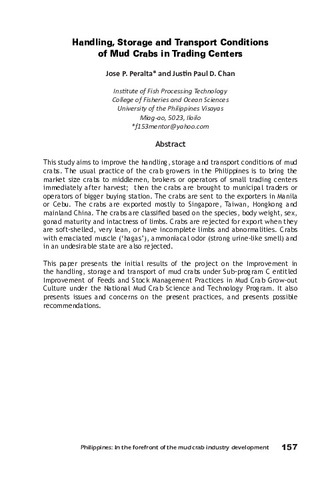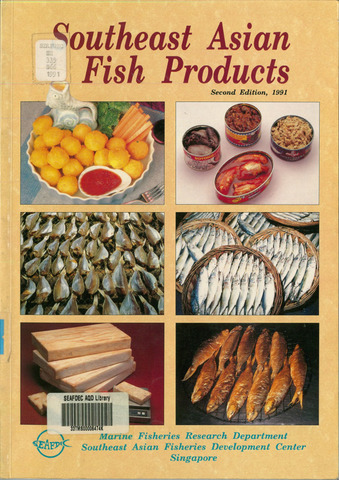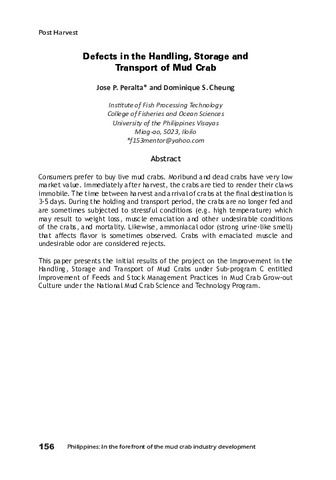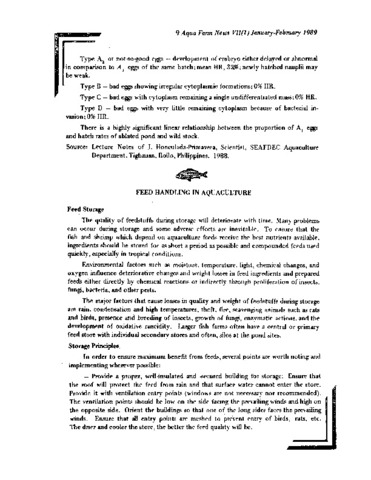Handling, storage and transport conditions of mud crabs in trading centers
Share
Abstract
This study aims to improve the handling, storage and transport conditions of mud crabs. The usual practice of the crab growers in the Philippines is to bring the market size crabs to middlemen, brokers or operators of small trading centers immediately after harvest; then the crabs are brought to municipal traders or operators of bigger buying station. The crabs are sent to the exporters in Manila or Cebu. The crabs are exported mostly to Singapore, Taiwan, Hongkong and mainland China. The crabs are classified based on the species, body weight, sex, gonad maturity and intactness of limbs. Crabs are rejected for export when they are soft-shelled, very lean, or have incomplete limbs and abnormalities. Crabs with emaciated muscle (‘hagas’), ammoniacal odor (strong urine-like smell) and in an undesirable state are also rejected.This paper presents the initial results of the project on the Improvement in the handling, storage and transport of mud crabs under Sub-program C entitled Improvement of Feeds and Stock Management Practices in Mud Crab Grow-out Culture under the National Mud Crab Science and Technology Program. It also presents issues and concerns on the present practices, and presents possible recommendations.
Description
Abstract only.
Suggested Citation
Peralta, J. P., & Chan, J. P. D. (2017). Handling, storage and transport conditions of mud crabs in trading centers. In E. T. Quinitio, F. D. Parado-Estepa, & R. M. Coloso (Eds.), Philippines : In the forefront of the mud crab industry development : proceedings of the 1st National Mud Crab Congress, 16-18 November 2015, Iloilo City, Philippines (p. 157). Tigbauan, Iloilo, Philippines: Aquaculture Department, Southeast Asian Fisheries Development Center.
Subject
stress  ; consumers
; consumers  ; crab culture
; crab culture  ; fish storage
; fish storage  ; fishery products
; fishery products  ; handling
; handling  ; harvesting
; harvesting  ; live storage
; live storage  ; marine crustaceans
; marine crustaceans  ; postharvest losses
; postharvest losses  ; purchasing
; purchasing  ; trade
; trade  ; transportation
; transportation  ; Scylla
; Scylla  ; Philippines
; Philippines 
 ; consumers
; consumers  ; crab culture
; crab culture  ; fish storage
; fish storage  ; fishery products
; fishery products  ; handling
; handling  ; harvesting
; harvesting  ; live storage
; live storage  ; marine crustaceans
; marine crustaceans  ; postharvest losses
; postharvest losses  ; purchasing
; purchasing  ; trade
; trade  ; transportation
; transportation  ; Scylla
; Scylla  ; Philippines
; Philippines 
Related items
Showing items related by title, author, creator and subject.
-
Southeast Asian fish products
Ng, Mui Chng; Hooi, Kok Kuang; Miwa, Katsutoshi (Marine Fisheries Research Department, Southeast Asian Fisheries Development Center, 1991)This report is a comprehensive record of fish products in the region, and will be of interest to researchers, food scientists, fish technologists and administrators. It will also be useful for fish traders, and may be used ... -
Defects in the handling, storage and transport of mud crab
Peralta, Jose P.; Cheung, Dominique S. (Aquaculture Department, Southeast Asian Fisheries Development Center, 2017)Consumers prefer to buy live mud crabs (Scylla). Moribund and dead crabs have very low market value. Immediately after harvest, the crabs are tied to render their claws immobile. The time between harvest and arrival of ... -
Feed handling in aquaculture
Carreon-Lagoc, Julia; Southeast Asian Fisheries Development Center, Aquaculture Department (Aquaculture Department, Southeast Asian Fisheries Development Center, 1989)




